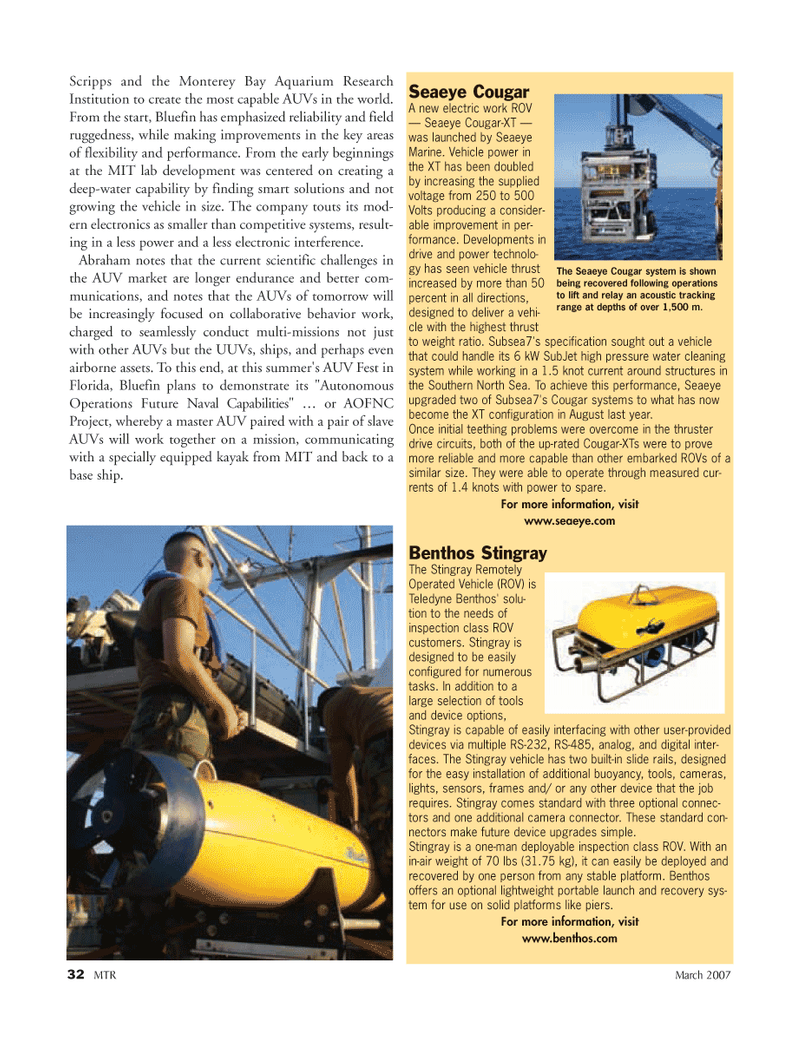
Page 32: of Marine Technology Magazine (March 2007)
AUVs, ROVs, UUVs
Read this page in Pdf, Flash or Html5 edition of March 2007 Marine Technology Magazine
32 MTR March 2007
Scripps and the Monterey Bay Aquarium Research
Institution to create the most capable AUVs in the world.
From the start, Bluefin has emphasized reliability and field ruggedness, while making improvements in the key areas of flexibility and performance. From the early beginnings at the MIT lab development was centered on creating a deep-water capability by finding smart solutions and not growing the vehicle in size. The company touts its mod- ern electronics as smaller than competitive systems, result- ing in a less power and a less electronic interference.
Abraham notes that the current scientific challenges in the AUV market are longer endurance and better com- munications, and notes that the AUVs of tomorrow will be increasingly focused on collaborative behavior work, charged to seamlessly conduct multi-missions not just with other AUVs but the UUVs, ships, and perhaps even airborne assets. To this end, at this summer's AUV Fest in
Florida, Bluefin plans to demonstrate its "Autonomous
Operations Future Naval Capabilities" … or AOFNC
Project, whereby a master AUV paired with a pair of slave
AUVs will work together on a mission, communicating with a specially equipped kayak from MIT and back to a base ship.
Seaeye Cougar
A new electric work ROV — Seaeye Cougar-XT — was launched by Seaeye
Marine. Vehicle power in the XT has been doubled by increasing the supplied voltage from 250 to 500
Volts producing a consider- able improvement in per- formance. Developments in drive and power technolo- gy has seen vehicle thrust increased by more than 50 percent in all directions, designed to deliver a vehi- cle with the highest thrust to weight ratio. Subsea7's specification sought out a vehicle that could handle its 6 kW SubJet high pressure water cleaning system while working in a 1.5 knot current around structures in the Southern North Sea. To achieve this performance, Seaeye upgraded two of Subsea7's Cougar systems to what has now become the XT configuration in August last year.
Once initial teething problems were overcome in the thruster drive circuits, both of the up-rated Cougar-XTs were to prove more reliable and more capable than other embarked ROVs of a similar size. They were able to operate through measured cur- rents of 1.4 knots with power to spare.
For more information, visit www.seaeye.com
Benthos Stingray
The Stingray Remotely
Operated Vehicle (ROV) is
Teledyne Benthos' solu- tion to the needs of inspection class ROV customers. Stingray is designed to be easily configured for numerous tasks. In addition to a large selection of tools and device options,
Stingray is capable of easily interfacing with other user-provided devices via multiple RS-232, RS-485, analog, and digital inter- faces. The Stingray vehicle has two built-in slide rails, designed for the easy installation of additional buoyancy, tools, cameras, lights, sensors, frames and/ or any other device that the job requires. Stingray comes standard with three optional connec- tors and one additional camera connector. These standard con- nectors make future device upgrades simple.
Stingray is a one-man deployable inspection class ROV. With an in-air weight of 70 lbs (31.75 kg), it can easily be deployed and recovered by one person from any stable platform. Benthos offers an optional lightweight portable launch and recovery sys- tem for use on solid platforms like piers.
For more information, visit www.benthos.com
The Seaeye Cougar system is shown being recovered following operations to lift and relay an acoustic tracking range at depths of over 1,500 m.
MTR#2 (17-32).qxd 3/2/2007 11:10 AM Page 32

 31
31

 33
33
